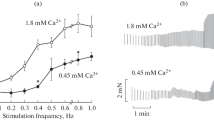Abstract
The effect of halothane on maximal and submaximal Ca2+-activated tension in mechanically disrupted right ventricular papillary muscle from rabbits was studied. Steady-state isometric tension generation was measured in the muscle bundle. The relaxing solution contained (in mM) [mg2+]=1, [K+]=70, [MgATP¨-]=2, [creatine phosphate¨-]=15, [EGTA total]=7 and imidazole proprionate. The contracting solution contained in addition Ca2+ in various concentrations. In all solutions ionic strength was maintained at 0.15 and pH at 7.00±0.02 at 20°C. Each fiber bundle was immersed in control solutions equilibrated with 100% N2 and test solutions equilibrated with various concentrations of halothane-N2 mixture. Increasing doses of halothane (1–4%) significantly shifted the relationship between Ca2+ and tension towards higher [Ca2+] and depressed the maximum Ca2+-activated tension. The maximum tension generated atpCa=3.8 was depressed 5% per 1% increase in halothane concentration. The percentage of maximum tension at submaximum Ca2+ concentrations (pCa=5.6–5.0) was not significantly decreased until halothane concentration was greater than 2%. It is concluded that halothane slightly but significantly depressed the interactions of contractile proteins and to a lesser degree Ca2+-activation of the regulatory proteins. The halothane-induced depression was completely reversible.
Similar content being viewed by others
References
Brown, B. R., Crout, J. R.: A comparative study of the effects of five general anesthetics on myocardial contractility: I. Isometric conditions. Anesthesiology34, 236–245 (1971)
Endo, M., Takagi, A., Ebashi, S.: Calcium release by halothane from the sarcoplasmic reticulum of skeletal muscle. Abstracts 6th International congress of Pharmacology., p. 565 (1975)
Fabiato, A., Fabiato, F.: Excitation-contraction coupling of isolated cardiac fibers with disrupted or closed sarcolemmas: calcium-dependent cyclic and tonic contractions. Circ. Res.31, 293–316 (1972).
Fink, B. R., Morikawa, K.: A simplified method for the measurement of volatile anesthetics in blood by gas chromatography. Anesthesiology32, 451–455 (1970)
Frederickson, E. L.: Electrophysiological changes in cardiac muscle incident to anesthetics. In B. R. Fink (ed.). Cellular biology and toxicity of anesthetics, pp. 142–155. Baltimore, Maryland: Williams and Wilkins 1972
Goldberg, A. H., Ullrick, W. C.: Effects of halothane on isolectric contractions of isolated heart muscle. Anesthesiology28, 838–845 (1967)
Hauswirth, O.: Effects of halothane on single atrial, ventricular, and purkinje fibers. Circ. Res.34, 745–750 (1969)
Hellam, D. C., Podolsky, R. J.: Force measurements in skinned muscle fibers. J. Physiol. (Lond.)200, 807–819 (1969)
Kerrick, W. G. L., Best, P. M.: Calcium ion release in mechanically disrupted heart cells. Science183, 435–437 (1974)
Kerrick, W. G. L., Donaldson, S. K. B.: The effects of Mg2+ on submaximum Ca2+-activated tension in skinned fibers of frog skeletal muscle. Biochim. Biophys. Acta275, 117–122 (1972)
Kerrick, W. G. L., Krasner, B.: Disruption of the sarcolemma of mammalian skeletal muscle fibers by homogenization. J. Appl. Physiol.39, 1052–1055 (1975)
Lain, R. F., Hess, M. L., Gertz, E. W., Briggs, F. N.: Calcium uptake activity of canine myocardial sarcoplasmic reticulum in the presence of anesthetic agents. Circ. Res.23, 597–604 (1968)
Leuwenkroon-Strosberg, E., Llaasberg, L. H., Hedley-Whyte, J.: Myosin conformation and enzymatic activity: Effect of chloroform, diethyl ether and halothane on optical rotatory disperision and ATPase. Biochim. Biophys. Acta.295, 178–187 (1973)
Merin, R. G., Kumazawa, T., Honig, C. R.: Reversible interaction between halothane and Ca2+ on cardiac actomyosin adenosine triphosphatase: Mechanism and significance. J. Pharmacol. Exp. Ther.190, 1–14 (1974)
Ohnishi, T., Pressman, G. S., Price, H. L.: A possible mechanism of anesthetic-induced myocardial depression. Biochem. Biophys. Res. Commun.57, 316–322 (1974)
Snedecor, G. W., Cochran, W. G.: Statistical methods. Ames. Iowa: Iowa University Press 1967
Takagi, A.: Abnormality of sarcoplasmic reticulum in malignant hyperpyrexia. Adv. Neurol Sci.20, 109–113 (1976)
Takagi, A., Sugita, H., Toyokura, Y., Endo, M.: Malignant hyperpyrexia, Effects of halothane on single skinned muscle fibers. Proc. Jap. Acad.52, 603–606 (1976)
Winegrad, S.: Studies of cardiac muscle with a high permeability to calcium produced by treatment with ethylenediaminetetraacetic acid. J. Gen. Physiol.58, 71–93 (1971)
Author information
Authors and Affiliations
Rights and permissions
About this article
Cite this article
Su, J.Y., Kerrick, W.G.L. Effects of halothane on Ca2+-activated tension development in mechanically disrupted rabbit myocardial fibers. Pflugers Arch. 375, 111–117 (1978). https://doi.org/10.1007/BF00584232
Received:
Issue Date:
DOI: https://doi.org/10.1007/BF00584232



